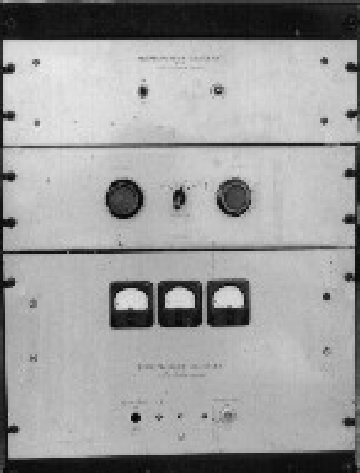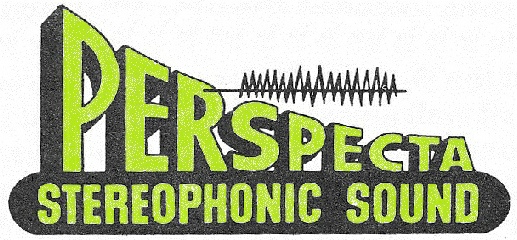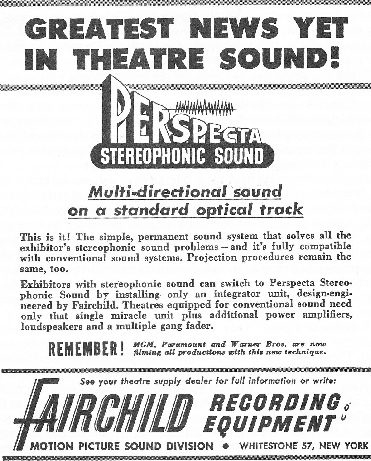The Perspecta decoder unit

In an effort to combat the inroads that the growing popularity of television was having on audiences of the day, the 1950s saw many innovations in the professional cinema industry. Cinemascope, multi channel magnetic sound, 3D and a greater use of color were but a few. Industry publications (1) of the time suggest that many exhibitors as well as their technical staff treated these innovations with indifference and in many cases put up a solid wall of resistance to change. Such was the fate of Perspecta Sound.
I
Introduced well before the advent of home stereo, this highly effective three channel sound system was installed in only a small percentage of cinemas, even when installed, it was often poorly presented, or even worse left turned off !
The first feature to be released with Perspecta sound was MGM’s Knights of the Round Table staring Robert Taylor and Ava Gardner in 1953. Prior to this Metro had released some cartoons and possibly other short subjects with Perspecta Sound. Many of the 1950s releases from MGM, Warner Bros. and Paramount (3) were presented in Perspecta. It’s demise came in 1960, mainly due to it’s poor promotion and lack of interest by exhibitors .
Many of the films at this time were released in different versions. Cinemascope had arrived and many ffilms of the time were released in both an ananamorphic (Cinemascope) version and a regular (flat) version. The same applied to the sound, some titles were released with multi-
The Perspecta multi-
Comparing a well mixed Perspecta sound presentation with today’s Dolby A stereo, the first thing that becomes apparent is that the sound is capable of following the performers on the screen. When an actor on screen right speaks, the sound comes from screen right, if another person speaks from screen left, the sound comes from screen left. This gives a true directional sound effect. This is not the case with Dolby A stereo surround, which mainly confines the dialogue to the centre channel, with left-
Although frequently referred to as stereo, Perspecta is not true stereo. The Perspecta system provided a system of electronically switching the mono sound track to any of three speaker systems placed behind the screen in a left-
The secret of Perspecta lies in the use of three low frequency tones to control the directional switching of the sound. These tones are recorded along with the usual music, dialogue and sound effects onto the normal mono optical sound track.
When in operation, if the Perspecta unit detects the presence of one or more of these sub-
There is one shortcoming with the system. Because there is only the one sound track available, when the sound is switched from one speaker to another to move with the action on the screen, if there is a musical background, the music will also follow the action. This would at first appear to be quite disconcerting, but it operation, it is barely noticeable.
Although Perspecta saw it’s demise in the early 1960s, a company in England is (1998) making new fully solid state decoders for around 300 pounds. These units plug directly into the Dolby CP55 series processor units and have the added enhancement of providing rear speaker drive when all three Perspecta ‘channels’ are present.
OPERATION
The basic block diagram above shows the signal flow through the Perspecta unit. Starting at the left side the sound from the operating projector is amplified in the pre amplifier and fed to the two filter stages. The high pass filter rejects the low frequency Perspecta tones, but passes all of the normal sound track audio through and feeds it to the three control gates. In the normal or non-
The low pass filter allows only the Perspecta low frequency control tones to pass through. They are applied to the detector stage, which determines if the film is in Perspecta, and if is, the three control gates are switched into Perspecta mode by the Perspecta on/off line. The control tones are also applied to the three filter stages. These filters are quite sharp, producing an output only if the exact corresponding frequency is present. The three outputs are connected to detectors ( not shown ) , which produce a voltage if the corresponding frequency is present. The detector’s output voltage is used to turn on it’s control gate, in the on position, it sends the sound track audio to the following amplifier stage, and then to the speakers.
Because the filters are quite sharp, their bandwidth is only about + or -
Although there is no real reason why the Perspecta system would not operate satisfactorily with 16mm, all of the 16mm Perspecta releases that I have been able to check, have not had the Perspecta tones recorded. Also, MGM and others have re-
References: 1. -
Footnotes:
1. Many of the well known 1950s releases were released in Perspecta versions, including most of the Paramount VistaVision releases as well as some Tom & Jerry CinemaScope cartoons. Unfortunately, there appears to be no authoritative listing available.
2. The author would be pleased to hear from anyone with Perspecta Sound films, even odd reels.

A past articles from the pages of
Reel Deals
The Australian Film Collectors’ Magazine
